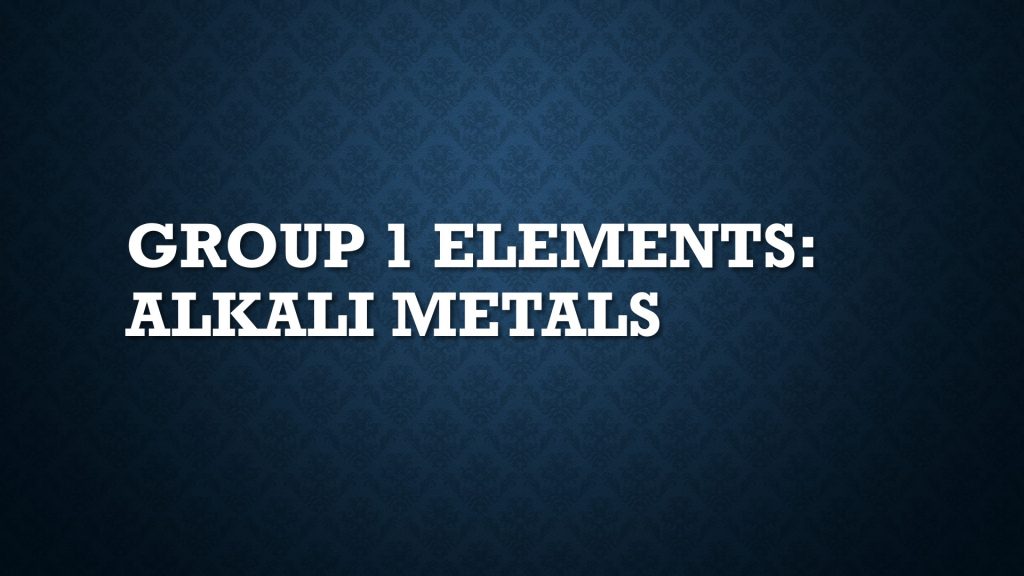Group-1 Elements of the Modern Periodic Table consist of Hydrogen(H), Lithium(Li), Sodium(Na), Potassium(K), Rubidium(Rb), Caesium(Cs), and Francium(Fr). Out of these elements except for hydrogen, the remaining elements are popularly known as the Alkali metals.

Index
History
Hydrogen gas was first recognized as a discrete substance, by Henry Cavendish in 1766. Before that Robert Boyle discovered and described between iron filings and dilute acids, which produced hydrogen gas as a result in 1671. The element was given its name by Antoine Lavoisier, in 1783, when he and Laplace reproduced Cavendish’s finding that water is produced when hydrogen is burned.
Lithium was discovered by Johan August Arfwedson while working in the laboratory of Jons Jacob Berzelius in 1817 when he detected the presence of a new element while analyzing the petalite ore(LiAlSi4O10).
Sodium compounds have been known since ancient times, in the form of salt. Experimental evidence suggesting the fundamental difference of soduium and potassium salts was obtained by Georg Ernst Stahl in 1702.
Humphry Davy was the first to isolate pure potassium, in 1807. This was done by deriving it from caustic potash by the use of electrolysis of the molten salt with the newly invented voltaic pile.
The first elements to be discovered using the spectroscope are rubidium and caesium.
Francium was discovered in France by Marguerite Perey in 1939, by purifying a sample of actinium-227, which had been reported to have decay energy of 220 keV.
Properties of Group 1 Elements or Alkali Metals
Now, let’s discuss the properties of group 1 elements which are physical properties and chemical properties.
Physical Properties
| Properties | Hydrogen | Lithium | Sodium | Potassium | Rubidium | Caesium | Francium |
| Atomic Symbol | H | Li | Na | K | Rb | Cs | Fr |
| Atomic Number | 1 | 3 | 11 | 19 | 37 | 55 | 87 |
| Atomic Mass (amu) | 1.008 | 6.94 | 22.99 | 39.09 | 85.46 | 132.90 | 223 |
| Atomic Radii (pm) | 53 | 152 | 186 | 227 | 248 | 265 | – |
| Valence Electronic Configuration | 1s1 | [He]2s1 | [Ne]3s1 | [Ar]4s1 | [Kr]5s1 | [Xe]6s1 | [Rn]7s1 |
| Melting/Boiling Points (K) | 13.99 / 20.271 | 453.69 / 1615.5 | 370.87 / 1156.15 | 336.53 / 1032.15 | 312.46 / 961.15 | 301.59 / 944.15 | – / – |
| Density (g/cm3) | 0.07 | 0.534 | 0.968 | 0.89 | 1.532 | 1.93 | – |
| Common Oxidation States | -1, +1 | +1 | -1, +1 | -1, +1 | -1, +1 | -1, +1 | +1 |
| Electronegativity | 2.20 | 0.98 | 0.93 | 0.82 | 0.82 | 0.79 | – |
| First Ionisation Enthalpy (kJ mol-1) | 1312.0 | 520.2 | 495.8 | 418.8 | 403.0 | 375.7 | – |
Chemical Properties
- Alkali metals react with water to produce a metal hydroxide solution and hydrogen gas.
2M + 2H2O → 2MOH + H2
- Alkali metals react with oxygen gas, while being heated, to produce white solid metal oxides.
4M + O2 → 2M2O
- They react with hydrogen at high temperatures to form metallic hydrides.
2M + H2 → 2MH
- The hydroxides of these metals react with carbon dioxide to give carbonates.
2MOH + CO2 → M2CO3 + H2O
- The nitrates of these elements are soluble in water and on heating they decompose to nitrites(except lithium nitrate).
2MNO3 → 2MNO2 + O2
- Sulphates of alkali metals except for lithium are soluble in water. These sulphates can also be reduced by Carbon to sulphides.
Trends in Group 1 Elements
- The atomic radii of group 1 elements increase down the group due to the shielding effect.
- The factors causing decreasing ionisation enthalpy down the group are nuclear charge, the amount of shielding by the inner electrons, and the distance from the most loosely held electron from the nucleus.
- The reactivity increase down the group due to the combination of two factors: the first ionisation energy and atomisation energies of the alkali metals.
- The falling melting and boiling points down the group is dues to the increase of atomic radii or atomic size down the group.
Applications of Group 1 Elements
- Hydrogen is quite frequently used in power stations as a coolant in generators.
- Lithium finds huge applications in lithium-ion batteries.
- Metallic lithium is used in alloys with magnesium and aluminium to increase their strength and make them light.
- Sodium in the form of sodium chloride is highly used as table salt.
- Pure Sodium is also used in sodium-vapour lamps.
- Potassium finds its application as fertilisers in agriculture.
- Potassium-sodium alloys are used in fast breeder nuclear reactors.
- Rubidium and caesium are used in atomic clocks.
- Rubidium ions are used in purple fireworks.
- Caesium is used in drilling fluids in the petroleum industry.
- Francium has no commercial applications but is used in spectroscopy experiments.
FAQs
Group 1 elements are called alkali metals as they form alkaline solutions when they react with water.
Group 1 elements have relatively low melting points, low densities and are soft.
All alkali metals react vigorously with cold water.
Related Articles
